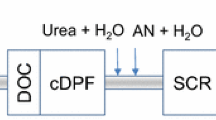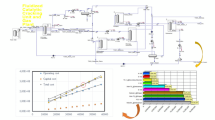Abstract
Selection of a good catalyst is the easiest way to increase profitability of a fluid catalytic cracking (FCC) unit. During operation, these catalysts get deactivated due to operation at high temperatures, steam and deposition of metals on the catalyst. Developing a proper catalyst deactivation method is crucial for optimization of a good catalyst for FCC. Conventional laboratory deactivation procedures include direct metal impregnation method, cyclic deactivation method (CDM) and cyclic propylene steaming (CPS). Direct metal impregnation method gives higher coke and gas yields. CDM and CPS methods implementation is very difficult and time-consuming and there is a deviation in coke and gas yield. New rapid deactivation method has been developed to simulate plant equilibrium catalyst (E-Cat) by modifying metal impregnation, steaming and oxidation/reduction procedures. The E-Cat generated through a new deactivation method was characterized for physico-chemical properties using X ray diffraction (XRD), temperature-programmed reduction (TPR), and SEM-EDX and activity studies. XRD studies show that metals are dispersed well on catalyst samples. SEMEDX studies reveal that the morphology of simulated E-Cat and plant E-Cat catalyst particles appear to be same. E-Cat obtained by new deactivation method gives better coke and gas yields. Two E-Cats were also generated through CDM and direct metal impregnation method for comparing with the one generated through new method. New deactivation method also significantly reduces the evaluation time and is cost-effective.

New deactivation method is developed for the simulation of fluid catalytic cracking equilibrium catalyst in laboratory. New deactivation method significantly reduces catalyst evaluation and selection time and is more cost-effective.







Similar content being viewed by others
References
Ravichander N, Chiranjeevi T, Gokak D T, Ravi Kumar V and Choudary N V 2009 Catal. Today 141(1–2) 115
Mitchell B R 1980 Ind. Eng. Chem. Prod. Res. Dev. 19 209
Gerritsen L A, Winjngaards H N J, Verwoert J and Connor P O 1994 Catal. Today 11 61
Magee J S and Mitchell Jr M M 1993 Stud. Surf. Sci. Catal. 76 223
Alyne S E, MarceloM P, Ricardo D M Pimenta, Lam Y Lau and Heriqque S C 2005 Appl. Catal. A 286 196
Wallenstein D, Kanz B and Harding R H 1999 Appl. Catal. 178 117
Wallenstein D, Harding R H, Wizler J and Zhao X 1988 Appl. Catal. 167 141
Bendiksen M, Tangstad E and Myrstad T 1995 Appl. Catal. 129 21
Karthikeyani A V, Mandal S, Das A K, Krishnan V and Makhija S 2008 Proc. Intercat Seminar,Mumbai, 21 February, p.38
Grace W R 1999 Grace Division Guide to FCC, part 3, Chapter 11
Biswas J and Maxwell I E 1990 Appl. Catal. 63 197
Rainer D R and Rautiainen E P 2003 Appl. Catal. A 249 69
Speronello B K and Reagan W J 1984 Oil Gas J. 30 139
Bayraktar O and Kugler E 2004 Appl. Catal. 260 125
Psarras A C, IIiopoulou E F, Nalbandian L, Lappas A A and Pouwels C 2007 Catal. Today 127 44
Acknowledgements
Authors thank Mr. N Ravichander for his contribution towards activity data and also thank the management of BPCL for permission to publish this data.
Author information
Authors and Affiliations
Corresponding author
Rights and permissions
About this article
Cite this article
CHIRANJEEVI, T., GOKAK, D.T., RAVIKUMAR, V. et al. Development of new deactivation method for simulation of fluid catalytic cracking equilibrium catalyst. J Chem Sci 126, 353–360 (2014). https://doi.org/10.1007/s12039-014-0583-2
Received:
Revised:
Accepted:
Published:
Issue Date:
DOI: https://doi.org/10.1007/s12039-014-0583-2




